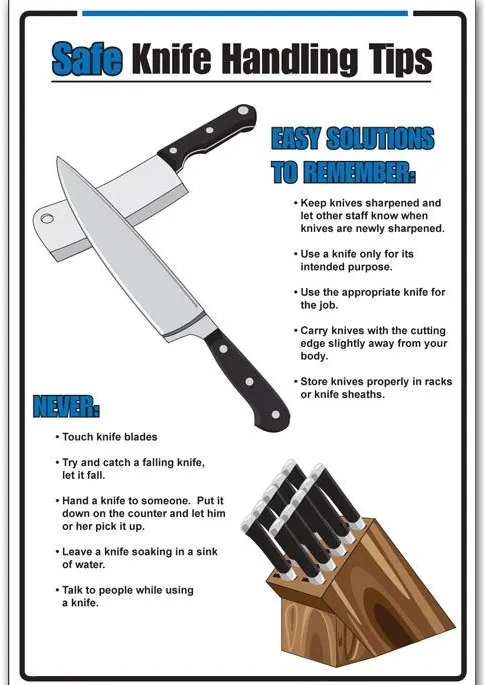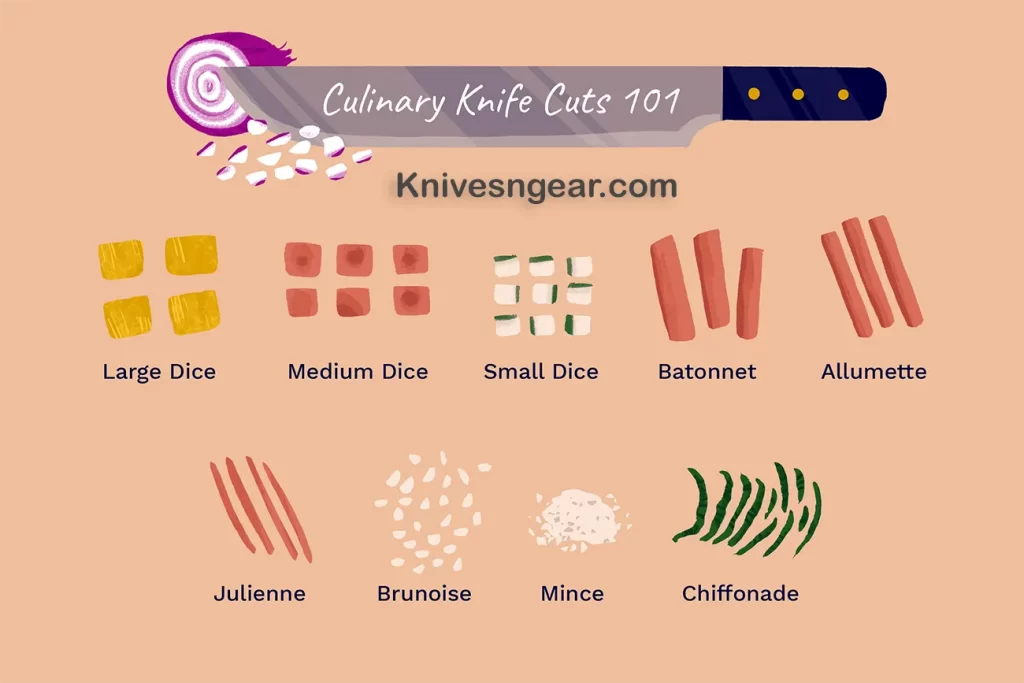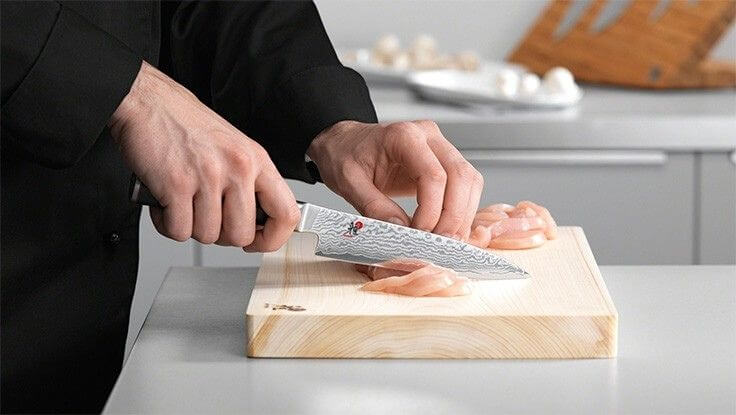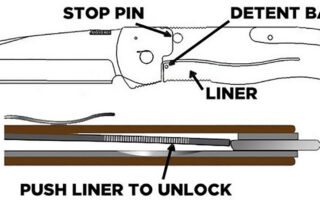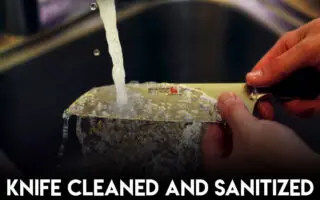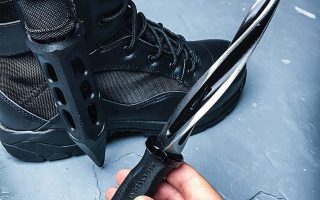How To Use Kitchen Knives Safely- Dos and Don’ts
Knife is more important than any other tools in the kitchen. With this tool you can do most of the works in the kitchen. This is why it is necessary to take good care of your knives. So understanding the safety rules will guide you properly to take a better care of your best friend in the kitchen. Firstly you have to take a deep look at the knife and identify if it is Japanese kitchen knife or not. There are tread marks on the blade of the knife which you can easily find. Japanese kitchen knives are the best choice for the chefs. You have to know how to use the handle, how to maintain the blade health. There are some Dos and Don’ts that you must follow to keep good care of your knife. We have explained 10 general knife tips below for you to follow.
General Knife Safety Tips
1. Always pick up the knife by it’s handle: Even though the blade of the knife is dry and dull, never ever pick your knife by grabbing the blade. This will spoil the smoothness of the blade and sometimes it may be one of the causes of your blade being rusted. And most importantly you might cut yourself severely. So pick up the knife by grabbing the handle. It will low the risk of cut and increase the chance of safety.
2. Choose the correct size for your task: Choose your knife depending on the task you are into. For example, if you are cutting a strawberry you might need a comparatively thin knife with a 6 inches blade, when you might need a much bigger and heavier one while it comes to chopping meat. A perfectly matched knife size will make your kitchen experience great and outstanding
3. Keep your knife clean: Wash your knife immediately after use. Make sure to let the knife air dry after washing it. Keep the handle of the knife clean and smooth. Don’t you ever try to use the knife if the handle is oily or slippery. It might cause a dangerous accident. A secure grip is a must in the case of using a knife.
4. Use a perfect surface while cutting: While slicing an onion or a small piece of fruit, always place a hard board beneath the cutting spot. This is decrease the amount of risk. Never cut anything by holding it on your hand. Most of the hand cuts happen while people cut an apple by grabbing it with hand. This is the most common mistake ever found in this case.
5. Don’t Rush: Don’t rush. Don’t try to make it quick. Cutting something is s serious work. Don’t take it easy. A lot of people make a common mistake which is cutting something while taking to someone and not concentrating on the work. That’s a disaster alarm, you obviously don’t want to end up cutting your finger apart while quarrelling with your spouse in a simple matter.
6. Put the knife in a safe Place: Don’t place the knife in random places after you are done working with it. That will be the most irresponsible work to do if you don’t care about the safety of your own family. Don’t let your knife lying around on the sink with soapy water. Someone might get themselves cut. And also don’t put them anywhere except the knife-racks.
7. Keep knives away from the children: Keep them out of children’s reach, I don’t have to explain why. Children are curious about everything and there is no way they will touch a knife and get through safely. Most of the knife accidents come from the children while the knives are easily accessible to them or when the parent’s are a little irresponsible. So, the best thing will be if you keep them even out of their sight.
8. Sharpen your knives: Not very often, but regularly sharpening will give you an excellent cutting edge while will make your cutting experience easier and smooth. You surely don’t want you make an extra effort and wait for an extra second while you are cutting a delicious piece of juicy watermelon. Sharpened knife will give you a great cutting edge so that you can cut the things with one easy stroke without putting extra pressure on it. That will save both your energy and time.
9. Hold the knife properly: Always hold the knife with your dominant hand. Hold it perfectly with a balance. Neither your hand should be closer to the blade, not it should be at the edge of the handle. Your hand should grip the handle perfectly with perfect proportion.
10. Don’t keep knives in the drawer: Drawer is not a suitable place for storing knives. This is one of those places where bacteria and fungi develop. This can ultimately damage your knife. I will suggest you should read Best Kitchen Knife Storage Ideas.
Why It Is Important To
I have already mentioned that knife is the most important tool in the kitchen. A lot of people love to spend a good amount of money for a good quality knife. But even the best of steel can go dull and useless if they are not properly taken care of. And also they can become useless with frequent use. So It is highly recommended to take a good care of your knife to make it long lasting.
Moreover, a dull knife can be risky too. Dull knives require more force and pressure to cut something. This increase the risk of cut. Sharp blades require less effort and pressure that decrease the chance of any major accidents.
Proper and good maintenance will make sure your blade remain sharp for a long time and reduce the chance of occurring any major accidents.
Knife Cutting Techniques
There are some cutting rules and techniques that you should follow to have a better knife experience. However, different people rely of different techniques and rules. There is nothing like the ideal technique of cutting. You can just choose the best one that makes you comfortable. There are more that 10 cutting techniques but here we are mentioning the major three of them.
The Bridge
In case you want to cut smaller ingredients like onions or fruits- follow the bridge technique. Make a bridge over the thing and form a nice and high arch shape on it. There must be plenty of room for the knife to meet up at the end of the cutting point. Hold the matter on your hand with your fingers on one side and your thumb on the other. Use your other hand to hold the knife and make a bridge on the upper surface. Make a cut that reaches at the middle of the item. And take another stroke beside the previous one and try to meet the cut with the end of the previous cut. Repeat the process as many pieces as you want. Just don’t rush. It is highly important you take your time to avoid cuts.
The Claw
This technique is most often used to stripe any ingredients. Place the item you want to make the slice of. Keep the flat side down. Grab the ingredient hold it with one hand (or finger in case of small ingredients). Hold the one side. Take the knife with the other hand and gently cut it following the edge into parallel. Repeat the process until it is completed. Make sure you keep your hand and finger in safe distance from the knife edge. Stop between each slice and make it slowly. Don’t you dare to rush the work or you will end up cutting your finger. Most of the expert and professional chefs are seen to do this job real fast. They are highly trained and skillful. Don’t try to follow or copy them if you are amateur.
Cross-Chop
The Cross-chop technique is quite similar to the previous claw technique. Here the ingredients are more likely the bigger ones like meat, bigger vegetables. In that case you require much larger knife. I will recommend you to use the 10 inches chopper . These knives are highly convenient and able to chop the materials quick and smooth. To perform cross-chop you just have to place the meat on the hard board. Cut it several time horizontally, them you need to rotate the board and and perform the same amount of cut crossing the previous cuts. You can also move your hand instead of rotating the board. Either way you feel comfortable.
Conclusion
In this article we have mentioned all the possible rules and dos that you must obey and some don’ts that you need to refrain from. You have to abide by all these rules in case you want a safe Knife using experience in your kitchen. We also tried to show some common cutting techniques that are most often used in the kitchen. Now all you have to do is find the purpose that you want to apply your knife for, and follow our instruction above that matches your purpose. Happy Cutting!

Hi, my name is Taras Kulakov and I’m a knife enthusiast. I have been collecting knives for over 30 years and I’ve owned literally thousands of different models over that time. My goal with this site is to share some of what I’ve learned about knives. You can find more info about Taras Kulakov here.

